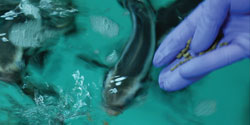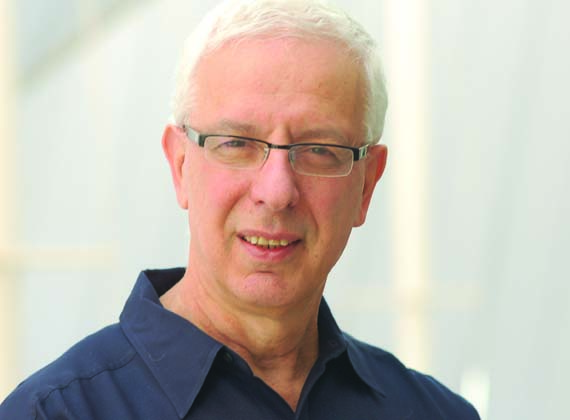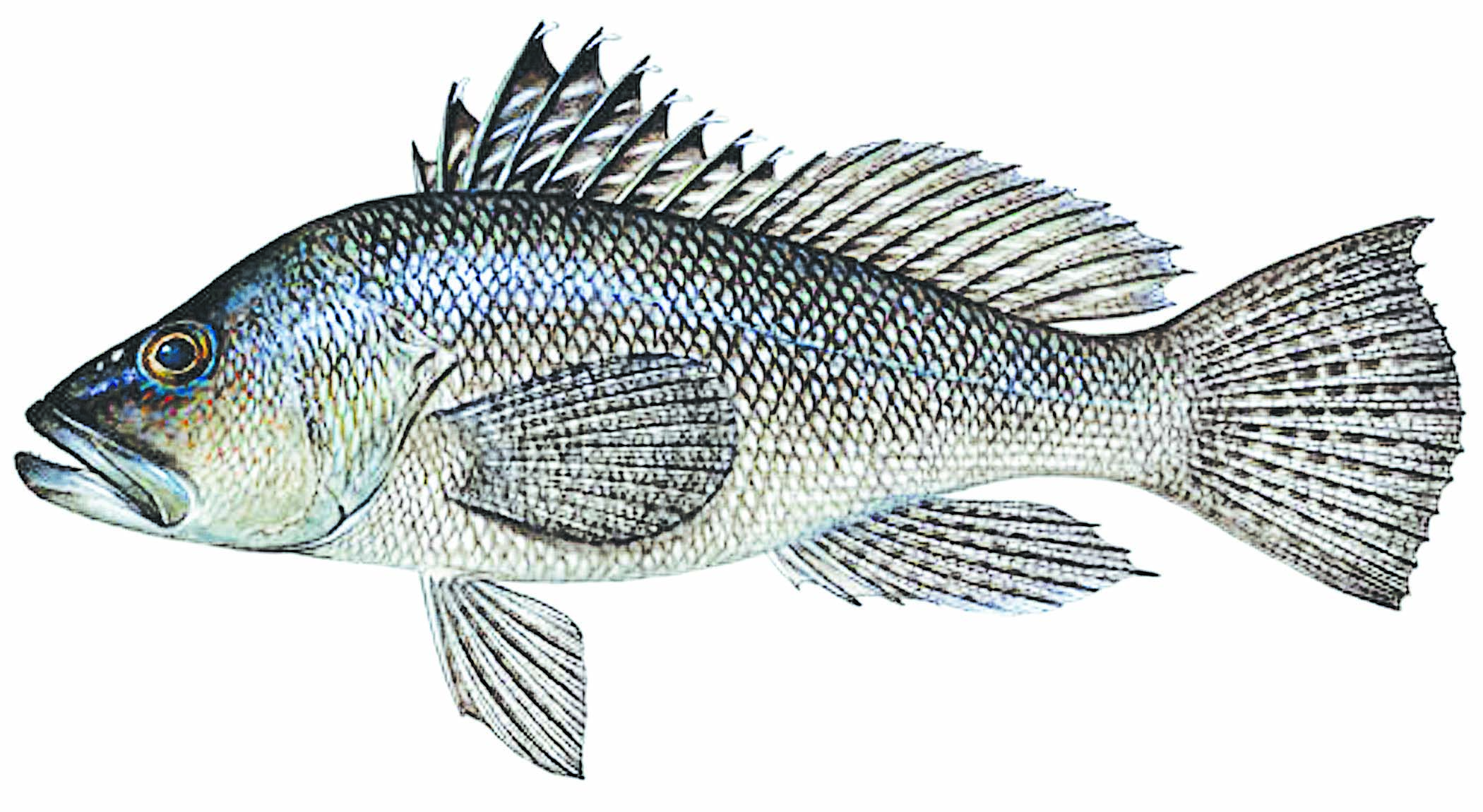 In UMBC’s Department of Marine Biotechnology, Yonathan Zohar and his colleagues are creating sustainable fish farms that may revolutionize our notions of fishing and seafood.
In UMBC’s Department of Marine Biotechnology, Yonathan Zohar and his colleagues are creating sustainable fish farms that may revolutionize our notions of fishing and seafood.
– By Anthony Lane
A well-known proverb appears on a wall near the entrance to the Columbus Center on Baltimore’s Inner Harbor: Give a man a fish, he eats for a day. Teach a man to fish and he eats for a lifetime.
A worthy sentiment, yes. But what happens if we use up the bounty of the world’s oceans and seas? Talk for a few minutes with aquaculture pioneer Yonathan Zohar and you might be moved to coin a new proverb:
Teach too many people to fish, and there might one day be nothing left to catch.
Zohar is chair of UMBC’s new Department of Marine Biotechnology. At the Columbus Center, he and his colleagues develop new techniques and technologies to protect the world’s oceans and seas and preserve the life inside them.
Pollution, climate change and gushing oil wells are all threats to aquatic systems. But even the act of fishing itself has advanced to a point of deadly efficiency: high-tech fishing fleets use spotters in airplanes and other techniques to maximize their catch and meet a growing global demand for seafood.
“If we don’t do anything about it,” Zohar observes, “the oceans could be out of 90 percent-plus of the major fishery stocks by the year 2050.” Many fisheries are already in serious trouble in 2011, he adds: “Cod used to be one of the most abundant fish out there. Now the cod fishery is almost gone. The giant bluefin tuna has been fished almost beyond repair.”
One answer to overfishing of natural waters is fish farms. But much of the news there is also troubling. Marine fish such as salmon and sea bass are typically raised in offshore floating net pens, where they cause pollution, absorb toxins, and exchange diseases with their wild cousins. Selectively bred farmed fish sometimes escape from their pens, displacing the natives or getting cozy with them.
So where will seafood come from in the future?
Zohar and his colleagues think they have an answer: a sustainable aquaculture system that they have developed in the Columbus Center’s basement. It uses a system of filters and pumps to clean and recirculate artificial seawater, providing ideal conditions for marine fish to grow and breed in safety. The fish can’t escape, and the design eliminates the risk of transmitting diseases or polluting coastal waters. Even the fish wastes are put to productive use: they are converted to methane, which can be used to help power the whole aquaculture system.
Humans have domesticated an array of animals and plants over the course of centuries to meet most of our food needs, Zohar observes. That still hasn’t happened with seafood.
“You don’t go to the wild to catch poultry or bovines,” he says. “Seafood is the only hunt-and-gather crop.”
Zohar believes that the aquaculture system at the Columbus Center – which could be used in landlocked Iowa just as easily as it can be used near the Inner Harbor – could be a green, clean and efficient way to raise fish anywhere.
A Tricky Business
 Zohar grew up in Jerusalem, and he developed an early fascination with oceans and marine life studying magazines such as National Geographic. Though he was close to the Mediterranean Sea all his life, it was not until he was teenager that he first visited the water during a school trip to the beach. “I loved it from first sight,” he says.
Zohar grew up in Jerusalem, and he developed an early fascination with oceans and marine life studying magazines such as National Geographic. Though he was close to the Mediterranean Sea all his life, it was not until he was teenager that he first visited the water during a school trip to the beach. “I loved it from first sight,” he says.
This passion for the sea eventually brought Zohar to Baltimore. In 1990, he joined the Center of Marine Biotechnology at the University System of Maryland to conduct aquaculture research. He later became the director of that center, remaining in that position until July 2010, when the center became the Institute of Marine and Environmental Technology (IMET), a partnership between UMBC, the University of Maryland Center for Environmental Science and the University of Maryland, Baltimore. Zohar continued on as IMET’s interim director, and he is chair of the new Department of Marine Biotechnology at UMBC.
Aquaculture was in its early stages when Zohar studied biology as an undergraduate at the Hebrew University of Jerusalem. Completing his master’s degree in oceanography in the mid-1970s, the young researcher started working at a national lab in Israel dedicated to developing techniques for raising marine fish such as European sea bass and sea bream. But progress in aquaculture in that era was stalled by a roadblock: The fish would not reproduce in captivity.
“We had to go collect juvenile fish in the wild,” Zohar recalls. “It was very clear this was not practical or reliable.”
Zohar eventually became an expert in reproduction, completing his Ph.D. in comparative endocrinology at the University of Pierre and Marie Curie in Paris in 1982. Reproduction is a tricky business with marine fish. In the wild, they will migrate hundreds or even thousands of miles to reach the spawning grounds where their offspring are most likely to survive. During these migrations, changes in temperature, water depth, salinity and other environmental factors essentially serve as an elemental sort of foreplay. The fish spawn only when these conditions are just right.
One way around the reproduction roadblock would be to mimic these environmental conditions in captivity. This approach wasn’t working, so Zohar decided to try something different, examining instead how the fishes’ hormonal systems respond to the environmental changes that lead to reproduction.
In an effort to understand why fish held in confinement fail to reproduce, Zohar’s research team collected spawning fish from the wild to compare them with their captive, reproductively challenged cousins. It became clear that a surge of a particular hormone resulted in spawning. His group traced the failure of captive fish to release this hormone to a malfunction in a related hormone system in the brain that produces what are known as gonadotropin-releasing hormones (GnRHs). They eventually found completely new forms of GnRH, a breakthrough that spurred reproductive research in animals and humans.
Zohar and his colleagues learned to synthesize a specific type of GnRH, and they discovered that injecting it into captive fish would trigger the reproductive response. Or the start of it, at least. After the injection, it turned out that enzymes in the fish would naturally break the hormone apart. So Zohar’s team spent a period of years developing a novel form of the hormone resistant to that process. They also engineered a “sustained delivery system” so that the hormone could be released at just the right pace to induce spawning.
That approach effectively cleared a path for the field of aquaculture to develop. In the recent New York Times bestseller Four Fish, Paul Greenberg details Zohar’s aquaculture research, characterizing his impact in bold terms. “Over the years he has gained a reputation as one of the world’s best at cracking the reproductive codes of the marine world.”
A Sustainable System
Challenges in marine aquaculture are not limited to reproduction. For a system to be sustainable, it must be engineered to reproduce in miniature the microbial processes that support life in the oceans.
The system Zohar and his colleagues have developed over the last 15 years now sprawls across 18,000 square feet in the Columbus Center’s basement. Zohar beams proudly as he leads tours through the facility, explaining how it defines a new level of sophistication in aquaculture systems.
“Ours is the first system in the world to be fully and completely self-contained,” Zohar says.
The Columbus Center is only two blocks from the National Aquarium in downtown Baltimore, and its aquaculture facility feels in many ways like an industrial version of its tourist-oriented neighbor. Massive round tanks brim with European sea bass, sea bream, cobia and other fish species. The fish circle intently, abruptly striking with open mouths when Zohar throws in a handful of food pellets.
Next to each tank, water churns through towering filtration units filled with what appear to be wagon-wheel pasta pieces. A labyrinth of pipes and tubes connects with a web of filters and sensors to keep the water within healthy limits for the fish.
The “seawater” in the tanks is actually manufactured; the system starts with dechlorinated tap water, which is mixed with salt and other trace elements to simulate what is found in the oceans. In this water, the fish go about their daily business, leaving behind wasted food and producing ammonia and feces that would soon turn the water into inhospitable sludge.
A network of filtration systems keeps the water in pristine condition. The first separates out the food and feces, producing a viscous, salty sludge. In freshwater systems, the sludge can be used as fertilizer. This can cause pollution, however, and it’s not an option given the leftover salt in marine systems.
Enter Kevin Sowers, a professor in the Department of Marine Biotechnology who is an expert on methane-producing bacteria. Over the years, he has helped find a blend of organisms that can effectively devour the sludge created in the Columbus Center aquaculture system and convert it into methane.
 “It’s very critical that all these organisms stay in balance,” Sowers observes. And when they do, 90 percent of the waste can be converted to methane.
“It’s very critical that all these organisms stay in balance,” Sowers observes. And when they do, 90 percent of the waste can be converted to methane.
The aquaculture system developed by Zohar and the marine biotechnology team has already been licensed to a private company for commercial production. When that system is up and running, Sowers says, it should be able to meet at least five to 10 percent of its electricity needs by burning this methane.
The other major waste product created by the system is ammonia. It’s relatively simple to convert ammonia into less toxic nitrogen compounds: Those filters filled with wagon-wheel-shaped pieces are designed specifically for this purpose. The plastic pieces are coated with a film of bacteria that thrive on ammonia, converting it into the nitrogen compounds nitrite and nitrate.
That’s only part of the process, however. The nitrogen compounds build up in the system over time. The nitrate, in particular, renders the water toxic. To get rid of it, aquarium owners and the operators of other land-based aquaculture systems are accustomed to frequently changing their water, but doing that in a commercial marine aquaculture system would be both costly and unsustainable.
Marine biotechnology faculty members Hal Schreier and Keiko Saito, along with other colleagues at the Columbus Center, developed a parallel filtration system that keeps the nitrate in check.
This system amounts to something of a high-wire act. Sulfate is a compound that occurs naturally in aquaculture systems, but aquaculture engineers have shied away from trying to use it productively due to an undesirable side reaction that produces toxic hydrogen sulfide, which could turn the water into an acidic broth.
The Columbus Center aquaculture system harnesses that reaction. Hydrogen sulfide is produced in one step by the bacteria residing in one waste chamber, and the compound is then channeled to another chamber where it is available to a special crop of finicky bacteria. Some of these bacteria consume a cocktail of hydrogen sulfide and nitrate, and churn out sulfate, hydrogen and harmless nitrogen gas in the process.
“We used the process that everyone wanted to avoid,” Schreier explains, “and we turned it to our advantage.”
Fishing for the Future
So where does the aquaculture system developed by Zohar and his colleagues go from here?
Adapting it to a commercial scale is one challenge. It could happen soon: A start-up company called Maryland Sustainable Mariculture has licensed the technology and is now looking for warehouse space that can accommodate an expanded operation. Zohar and his team will help with that effort.
Schreier says there are still parts of the innovative set-up that could be fine-tuned. Though the present aquaculture system minimizes pollution, it still produces a minimal amount of phosphate. The compound shows up as white flakes that must be collected and removed.
Schreier imagines that researchers will one day find a chemical or biological pathway to eliminate this waste product.
Marine biotechnology members are also continuing research on other fronts, including the use of bacteria to break down contaminants in the ocean, the development of algae that can be used in the production of biofuels and the exploration of the seas as a source of new pharmaceuticals.
Zohar envisions a future where aquaculture and marine biotechnology both contribute to the health of the world’s oceans.
“We have too many fishermen,” Zohar says, “and too many fishing boats.”
For now, anyway. Zohar predicts a more sustainable future: “Fishermen, I think, can readily become aquaculturists.”
Tags: Winter 2011, Yonathan Zohar



